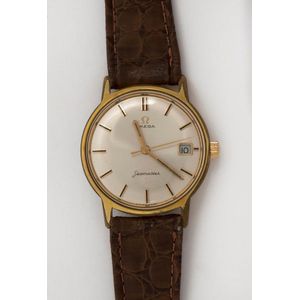Vintage Omega Seamaster Automatic Wristwatch, 1960, Rolled Gold & Stainless
Omega 'Seamaster' automatic wristwatch in rolled gold and stainless steel case with silver dial, date window, baton numerals and brown band, circa 1960, 3.7 cm wide including crown
You must be a subscriber, and be logged in to view price and dealer details.
Subscribe Now to view actual auction price for this item
When you subscribe, you have the option of setting the currency in which to display prices to $Au, $US, $NZ or Stg.
This item has been sold, and the description, image and price are for reference purposes only.
- Circa - A Latin term meaning 'about', often used in the antique trade to give an approximate date for the piece, usually considered to be five years on either side of the circa year. Thus, circa 1900 means the piece was made about 1900, probably between 1895 and 1905. The expression is sometimes abbreviated to c.1900.
- Baton Numerals - A watch that instead of displaying numerals on the face, displays a marker in the form of a baton, or lower case letter "L". Since the baton-like marks are not numerals, the feature is also called baton markers, baton indexes and baton indicators.
- Date Aperture - A date aperture is a cut out section in the face of a watch or clock, displaying the day of the month.
- Rolled Gold - A type of gold plating devloped in the early 19th century, similar to Sheffield plating of silver, where the the gold is fused under pressure and heat to a base metal, usually brass, and then rolled into sheets of the required thickness.
The thickness of the gold plate can vary. In Britain the thickness of the gold is measured in microns. A micron is one-thousandth of a millimetre and 20 microns of gold is considered good quality. In the USA a differnt method is used that takes account of the total weight of the object.
Also, the purity of the gold, measured in carats can vary, with 24 carat being the purest. The gold in most rolled gold objects will be between 9 and 14 carats.
There are other chemical and electroplating methods of applying gold plate to a base metal, but rolled gold is considered a superior plate to a "gold plated" object.
Depending on the country and date of manufacture, the object may be stamped "Rolled Gold" or similar, but if there is any doubt as to whether an object is solid gold, or some type of gold plating, it is preferable to have it tested by a jeweller.
This item has been included into following indexes:
